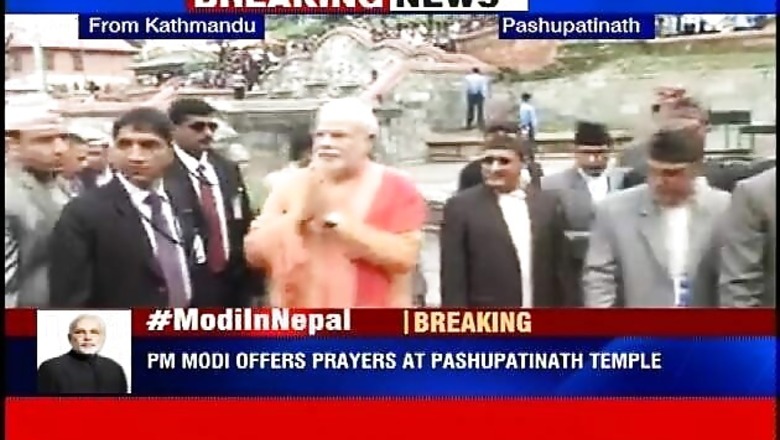
views
Kathmandu: Prime Minister Narendra Modi on Monday offered special prayers at Nepal's famed centuries-old Pashupatinath Temple and "felt extremely blessed". A devout Hindu, 63-year-old Modi was at the temple of Lord Shiva for about 45 minutes on a 'Shravan ashtami' which is considered auspicious.
"Felt extremely blessed on offering prayers at Pashupatinath Temple this morning," Modi tweeted after offering the puja at 5th century temple on the second and last day of his maiden trip to Nepal after assuming office in May.
He donated 2500 kgs of sandalwood to the Pashupatinath Temple which is located on the banks of the Bagmati River in Deopatan, a village 3 km northwest of Kathmandu. 150 priests participated in the special puja during which Modi performed 'rudra abhishek' and had 'panch amrit snan', a priest said later.
Modi, in saffron dress, emerged from the temple wearing 'rudraksh malas'.
In the visitors' book, the Prime Minister wrote that the temple is "unique".
"Pashupatinath and Kashi Vishwanath (of Varanasi) are the same. I am full of emotions and I pray that the blessings of Pashupatinath, which unite Nepal and India, may continue for people of the two countries," wrote Modi, who was elected to Parliament from Varanasi, the city known as the abode of Lord Shiva.
The Pashupatinath temple is dedicated to a manifestation of Shiva called Pashupati (Lord of Animals). It attracts thousands of pilgrims each year, mostly from India. There are a lot of Indian pujaris at the temple. There is a tradition of keeping four priests and one chief priest at the temple from among the Bramhins of south India for centuries.
According to legend, the temple was constructed by Pashupreksha of the Somadeva Dynasty in the 3rd century BC, but the first historical records date from the 13th century. The ascetic Pashupata sect was likely related to its foundation.
Pashupati was a tutelary deity of the ancient rulers of the Kathmandu Valley; in 605 AD, Amshuvarman considered himself favored by his touching of the God's feet.
By the later Middle Ages, many imitations of the temple had been built, such as in Bhaktapur (1480), Lalitpur (1566) and Benares (early 19th century). The original temple was destroyed several times until it was given its present form under King Bhupalendra Malla in 1697.
According to a legend recorded in local texts, especially the Nepalamahatmya and the Himavatkhanda, the Hindu god Shiva once fled from the other gods in Varanasi to Mrigasthali, the forest on the opposite bank of the Bagmati River from the temple.
There, in the form of a gazelle, he slept. When the gods discovered him there and tried to bring him back to Varanasi, he leapt across the river to the opposite bank, where one of his horns broke into four pieces. After this, Shiva became manifest as Pashupati (Lord of Animals) in a four-face (chaturmukha) linga.




















Comments
0 comment